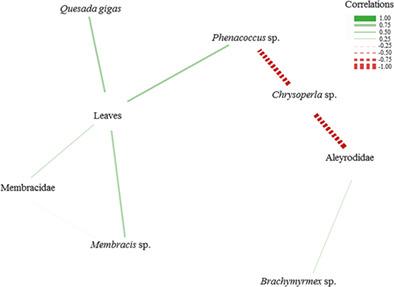当前位置:
X-MOL 学术
›
Ann. Appl. Biol.
›
论文详情
Our official English website, www.x-mol.net, welcomes your feedback! (Note: you will need to create a separate account there.)
Fertilisation with dehydrated sewage sludge affects the phytophagous Hemiptera, tending ants and Sternorrhyncha predators on Acacia mangium (Fabaceae)
Annals of Applied Biology ( IF 2.6 ) Pub Date : 2021-06-07 , DOI: 10.1111/aab.12706 Júlia Letícia Silva 1 , Germano Leão Demolin Leite 1 , Rafael Eugenio Maia Guanabens 1 , Alcinei Mistico Azevedo 1 , Geraldo Wilson Fernandes 2 , José Cola Zanuncio 3
Annals of Applied Biology ( IF 2.6 ) Pub Date : 2021-06-07 , DOI: 10.1111/aab.12706 Júlia Letícia Silva 1 , Germano Leão Demolin Leite 1 , Rafael Eugenio Maia Guanabens 1 , Alcinei Mistico Azevedo 1 , Geraldo Wilson Fernandes 2 , José Cola Zanuncio 3
Affiliation

|
Macro- and micronutrients from dehydrated sewage sludge are important for the development of plants such as Acacia mangium in processes for recovering degraded areas. The abundance, diversity and species richness of phytophagous Hemiptera, tending ants and Sternorrhyncha predators on A. mangium plants fertilised with dehydrated sewage sludge in a degraded area, compared to trees which did not receive this fertiliser, were evaluated. The experiment was completely randomised, with two treatments (either with or without dehydrated sewage sludge) and 24 replications. The abundance of phytophagous Hemiptera and tending ants was higher on plants fertilised with dehydrated sewage sludge and was similar between the two treatments for Sternorrhyncha predators. The diversity and richness of tending ant species were lower and higher in the treatments with or without dehydrated sewage sludge, respectively. Aethalion reticulatum and Quesada gigas Olivier were more abundant on fertilised plants, Acrogonia sp. was more abundant on nonfertilised ones, and other sucking insects were similar between the two treatments. The abundance of Brachymyrmex sp., Cephalotes sp., Pseudomyrmex termitarius and Syrphus sp. was higher on A. mangium plants which had been fertilised with dehydrated sewage sludge, and that of Cycloneda sanguinea was higher on nonfertilised plants. Membracis sp., Phenacoccus sp. and Q. gigas showed higher abundance as the total number of A. mangium leaves increased. Aleyrodidae abundance increased with Brachymyrmex sp., while Chrysoperla sp. reduced that of Aleyrodidae and Phenacoccus sp. The larger plant crown of A. mangium fertilised with dehydrated sewage sludge explains the greater abundance of phytophagous Hemiptera and tending ants and indicates its potential for recovering degraded areas.
中文翻译:

用脱水污水污泥施肥会影响 Acacia mangium (Fabaceae) 上的植食性半翅目、抚育蚂蚁和 Sternorrhyncha 捕食者
来自脱水污水污泥的常量和微量营养素对于在恢复退化地区的过程中开发诸如金合欢等植物很重要。A. mangium植食性半翅目、抚育蚂蚁和胸鳍食肉动物的丰度、多样性和物种丰富度与没有接受这种肥料的树木相比,对退化地区用脱水污泥施肥的植物进行了评估。实验是完全随机的,有两个处理(有或没有脱水的污水污泥)和 24 次重复。在用脱水污水污泥施肥的植物上,食草半翅目和抚育蚂蚁的丰度更高,并且在两种处理 Sternorrhyncha 捕食者之间相似。有或没有脱水污泥的处理分别降低和提高抚育蚂蚁物种的多样性和丰富度。Aethalion reticulatum和Quesada gigas Olivier 在受精植物Acrogonia上更丰富sp. 未受精的昆虫数量更多,两种处理之间的其他吸吮昆虫相似。Brachymyrmex sp.、Cephalotes sp.、Pseudomyrex termitarius和Syrphus sp.的丰度。在用脱水污泥施肥的A. mangium植物上更高,而在未施肥的植物上,Cycloneda sanguinea 的含量更高。Membracis sp., Phenacoccus sp. 随着A. mangium叶子总数的增加,Q. gigas显示出更高的丰度。Aleyrodidae 的丰度随着Brachymyrmex sp. 的增加而增加,而金藻属 减少了 Aleyrodidae 和Phenacoccus sp。用脱水污水污泥施肥的A. mangium较大的植物冠解释了食草半翅目和抚育蚂蚁的丰度更大,并表明其恢复退化地区的潜力。
更新日期:2021-06-07
中文翻译:

用脱水污水污泥施肥会影响 Acacia mangium (Fabaceae) 上的植食性半翅目、抚育蚂蚁和 Sternorrhyncha 捕食者
来自脱水污水污泥的常量和微量营养素对于在恢复退化地区的过程中开发诸如金合欢等植物很重要。A. mangium植食性半翅目、抚育蚂蚁和胸鳍食肉动物的丰度、多样性和物种丰富度与没有接受这种肥料的树木相比,对退化地区用脱水污泥施肥的植物进行了评估。实验是完全随机的,有两个处理(有或没有脱水的污水污泥)和 24 次重复。在用脱水污水污泥施肥的植物上,食草半翅目和抚育蚂蚁的丰度更高,并且在两种处理 Sternorrhyncha 捕食者之间相似。有或没有脱水污泥的处理分别降低和提高抚育蚂蚁物种的多样性和丰富度。Aethalion reticulatum和Quesada gigas Olivier 在受精植物Acrogonia上更丰富sp. 未受精的昆虫数量更多,两种处理之间的其他吸吮昆虫相似。Brachymyrmex sp.、Cephalotes sp.、Pseudomyrex termitarius和Syrphus sp.的丰度。在用脱水污泥施肥的A. mangium植物上更高,而在未施肥的植物上,Cycloneda sanguinea 的含量更高。Membracis sp., Phenacoccus sp. 随着A. mangium叶子总数的增加,Q. gigas显示出更高的丰度。Aleyrodidae 的丰度随着Brachymyrmex sp. 的增加而增加,而金藻属 减少了 Aleyrodidae 和Phenacoccus sp。用脱水污水污泥施肥的A. mangium较大的植物冠解释了食草半翅目和抚育蚂蚁的丰度更大,并表明其恢复退化地区的潜力。



























 京公网安备 11010802027423号
京公网安备 11010802027423号